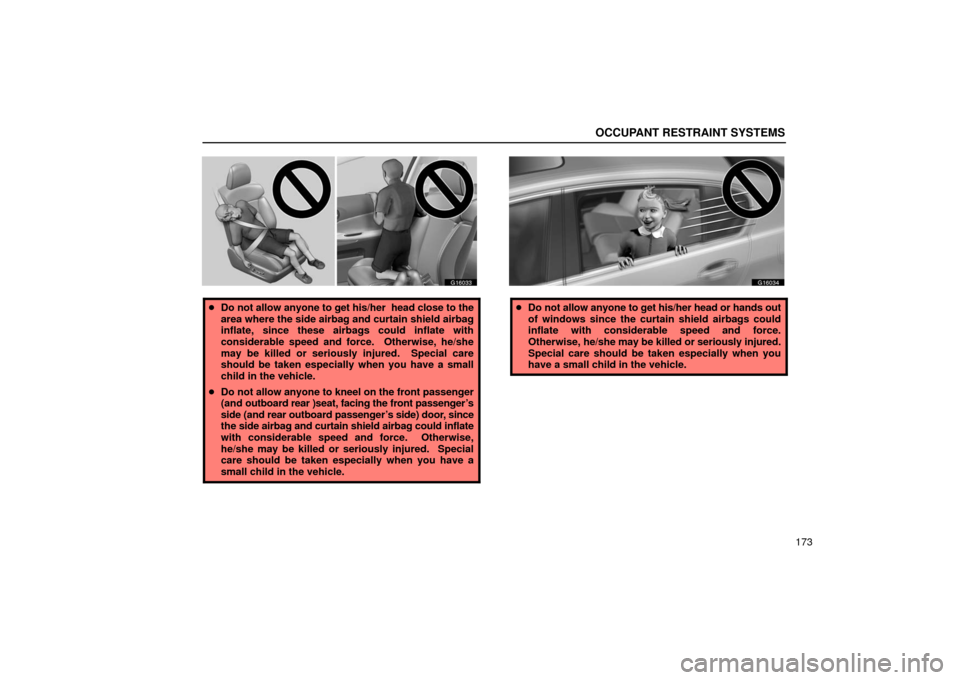Page 194 of 622

OCCUPANT RESTRAINT SYSTEMS
173
G16033
�Do not allow anyone to get his/her head close to the
area where the side airbag and curtain shield airbag
inflate, since these airbags could inflate with
considerable speed and force. Otherwise, he/she
may be killed or seriously injured. Special care
should be taken especially when you have a small
child in the vehicle.
� Do not allow anyone to kneel on the front passenger
(and outboard rear )seat, facing the front passenger’s
side (and rear outboard passenger’s side) door, since
the side airbag and curtain shield airbag could inflate
with considerable speed and force. Otherwise,
he/she may be killed or seriously injured. Special
care should be taken especially when you have a
small child in the vehicle.
G16034
� Do not allow anyone to get his/her head or hands out
of windows since the curtain shield airbags could
inflate with considerable speed and force.
Otherwise, he/she may be killed or seriously injured.
Special care should be taken especially when you
have a small child in the vehicle.
Page 226 of 622

STEERING WHEEL AND MIRRORS
205
Automatic tilt away*
G17003
When the engine switch is off, the steering column moves
forward away from the driver and also tilts up for easy exit
and entry.
When you turn on the engine switch, the steering column
returns to the previously set position.
NOTE:
*This feature can be deactivated.
Ask your Lexus dealer for details.
OUTSIDE REAR VIEW MIRRORS
G17004
Adjust the mirror so that you can just see the side of your
vehicle in the mirror.
Be careful when judging the size or distance of any object seen
in the outside rear view mirror on the passenger’s side
because it is a convex mirror. Any object seen in a convex
mirror will look smaller and farther away than if seen in a normal
flat mirror.
When the inside rear view mirror darkens in ”AUTO” mode, the
outside rear view mirrors also darken to reduce the reflection
of the headlights of the following vehicle. For details, see
”Inside rear view mirror” on page 209.
When you push the rear window and outside rear view mirror
defogger switch, the heater panels in the outside rear view
mirrors will quickly clear the mirror surface. (See “Rear window
and outside rear view mirror defogger switch” on page 56.)
Page 227 of 622

STEERING WHEEL AND MIRRORS
206
CAUTION
�Do not adjust the mirror while the vehicle is moving.
Doing so may cause the driver to mishandle the
vehicle and an accident may occur resulting in death
or serious injuries.
� Since the mirror surfaces can get hot, do not touch
them when the rear window and outside rear view
mirror defogger switch is on.
Power rear view mirror control
The power rear view mirror control switch is located in the
switch box.
G17013
� 1
Master switch 2Control switch
Push the button to use the switch box. Push “L” (left
mirror) or “R” (right mirror) on the master switch and then
push the control switch on the desired side.
The indicator light of the switch you selected comes on when
you push “L” or “R”.
When you move the selector lever to “R” position with “L” or “\
R”
switch on, the rear view mirrors will be automatically adjusted
down to help backing up.
While the indicator light is on, the mirror can be adjusted.
When you push the same side again, the light goes out and the
mirror cannot be adjusted. After adjustment, be sure to close
the switch box to its original position.
The power rear view mirrors can be adjusted when the engine
Page 234 of 622

STEERING WHEEL AND MIRRORS
213
G17012
Drive the vehicle slowly (at 8 km/h (5 mph) or lower) in a circle
until the direction is displayed. If there is not enough space to
drive in a circle, drive around the block until the direction is
displayed.
After driving in 1 to 3 circles in the above method, calibration
is complete with the “CAL” off the display and the direction
shown on the display.
If calibration cannot be performed because of the vehicle is
magnetized, take your vehicle to a Lexus dealer.
� Do not perform circling calibration of the compass in a place
where the earth’s magnetic field is subject to interference by
artificial magnetic fields (underground parking, under a
steel tower, between buildings, roof parking, near a
crossing, near a large vehicle, etc.).
� During calibration, do not operate electric systems (moon
roof, power windows, etc.) as they may interfere with the
calibration.
CAUTION
�When doing the circling calibration, be sure to secure
a wide space, and watch out for people and vehicles
in the neighborhood. Do not violate any local traffic
rules while performing circling calibration.
� Do not adjust the display while the vehicle is moving.
Be sure to adjust the display only when the vehicle is
stopped.
Page 243 of 622
TOUCH SCREEN
222
G18005
You can use the microphone above when talking on the
phone.
The party’s voice outputs from the driver’s speaker. When the
received calls or received voice outputs, the audio from the
audio system or voice guidance from the Navigation system
will be muted.
INFORMATION
� Talk alternately with your party on the phone. If you
talk at the same time, the voice may not reach each
other. (It is not a malfunction.)
� Keep the volume of receiving voice down. Otherwise,
echo is coming up. When you talk on the phone,
speak clearly towards the microphone.
� In the following situations, your voice may not reach
the party.
�Driving on unpaved road. (Making a traffic noise.)
�Driving at the high speed.
�The window is open.
�Turning the air conditioning vents towards the
microphone.
�The sound of the air conditioning fan is loud.
Page 282 of 622

AIR CONDITIONING
261
If manual switching of air intake is desired—
G21008
Each time you push the air intake control button, the mode
changes in order from the RECIRCULATED AIR mode to
AUTOMATIC mode to OUTSIDE AIR mode, then back to the
RECIRCULATED
AIR mode. Each indicator light shows which
mode is now selected.
1 RECIRCULATED AIR mode— If quick circulation of
cooled air is desired, select this mode.
2 EXHAUST GAS AUTOMATIC mode—If the outside air
contains harmful substances like exhaust gas (i.e., when
the vehicle running just in front of your vehicle accelerates
rapidly), the system changes automatically from the
OUTSIDE AIR mode (with indicators
2
and 3 on) to
the RECIRCULATED AIR mode (with indicators 1
and 2 on).
3 OUTSIDE AIR mode—The system will take fresh outside
air into the vehicle. Turning off the air conditioning manually will cancel the
EXHAUST
GAS AUTOMATIC mode. If you select the “AUTO”
mode during fan operating, the air conditioning turns on and
the EXHAUST GAS AUTOMATIC mode will operate.
For normal use, it is best to keep the air intake control button
set to OUTSIDE AIR mode. If recirculated air is used during
heating, the windows will fog up more easily.
Page 285 of 622

AIR CONDITIONING
264
(c) Micro dust and pollen filter
This vehicle is equipped with a micro dust and pollen filter
mode. When this mode is activated, air from the vents will
remove pollen on the driver and passengers.
G21073
Push the micro dust and pollen filter button.
The indicator light and “A/C” switch come on and
RECIRCULATED AIR mode is turned on. Air is delivered from
the instrument panel vents to the areas near the driver and
passengers to remove pollen on them.
When the interior is purified sufficiently with fresh air (after
about 3 minutes at normal outside temperature and about 1
minute at low outside temperature), this mode will be turned off
automatically and the indicator light will go out.
When the micro dust and pollen filter is activated, this mode will
be turned off by pushing the micro dust and pollen filter button
again. The indicator light will also go out.
INFORMATION
� Use this mode to remove pollen quickly carried by the
driver or passengers or through the window in the
days with much pollen.
� Use and push the windshield air flow button to
remove the fog on the windshield in rainy days.
� Fresh air is delivered even when the micro dust and
pollen filter button is turned off.
Page 286 of 622

AIR CONDITIONING
265
(d) Operating tips
�To help cool down the interior after parking in the hot sun,
drive for the first few minutes with the windows open. After
the excess heat has blown away, close the windows.
� Make sure the air inlet grilles in front of the windshield are
not blocked by leaves or other obstructions.
� If air flow control is not satisfactory, check the dashboard
vents and rear vents. (See (e) “Center vents, side vents and
rear vents”.)
� Only humid days, do not blow cold air on the windshield.
The windshield could fog up because of the difference in air
temperature on the inside and outside of the windshield.
� Keep the area under the front seats clear to allow air to
circulate throughout the vehicle.
� On cold days, set the fan speed to high for a minute to help
clear the intake ducts of snow or moisture. This can reduce
the amount of fogging on the windows.
� When driving on dusty roads, close all windows. If dust
thrown up by the vehicle is still drawn into the vehicle after
closing the windows, it is recommended that the air intake
control button be set to the OUTSIDE AIR mode to take in
the fresh air and the fan speed selector to any setting except
OFF. �
If following another vehicle on a dusty road, or driving in
windy and dusty conditions, it is recommended that the air
intake control button be temporarily pressed in to the
RECIRCULATED AIR mode, which will close off the outside
passage and prevent outside air and dust from entering the
vehicle interior.
Heating
For best results, set controls to:
For automatic operation—
Push in the “AUTO” button.
Temperature—To the desired temperature
Air intake—OUTSIDE AIR
Air conditioning—OFF
For manual operation—Fan speed—To the desired fan speed
Temperature—Towards high temperature
Air intake—OUTSIDE AIR
Air flow—FLOOR
Air conditioning—OFF
� For quick heating, select RECIRCULATED AIR mode for a
few minutes. To keep the windows from fogging, select
OUTSIDE AIR mode after the vehicle interior has been
warmed.
� Touch the “A/C” switch on for dehumidified heating.
� Choose floor/windshield air flow to heat the vehicle interior
while defrosting or defogging the windshield.